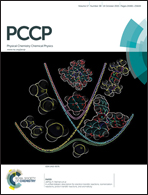Effect of H bond removal and changes in the position of the iron–sulphur head domain on the spin–lattice relaxation properties of the [2Fe–2S]2+ Rieske cluster in cytochrome bc1†
Abstract
Here, comparative electron spin–lattice relaxation studies of the 2Fe–2S iron–sulphur (Fe–S) cluster embedded in a large membrane protein complex – cytochrome bc1 – are reported. Structural modifications of the local environment alone (mutations S158A and Y160W removing specific H bonds between Fe–S and amino acid side chains) or in combination with changes in global protein conformation (mutations/inhibitors changing the position of the Fe–S binding domain within the protein complex) resulted in different redox potentials as well as g-, g-strain and the relaxation rates (T1−1) for the Fe–S cluster. The relaxation rates for T < 25 K were measured directly by inversion recovery, while for T > 60 K they were deduced from simulation of continuous wave EPR spectra of the cluster using a model that included anisotropy of Lorentzian broadening. In all cases, the relaxation rate involved contributions from direct, second-order Raman and Orbach processes, each dominating over different temperature ranges. The analysis of T1−1 (T) over the range 5–120 K yielded the values of the Orbach energy (EOrb), Debye temperature θD and Raman process efficiency CRam for each variant of the protein. As the Orbach energy was generally higher for mutants S158A and Y160W, compared to wild-type protein (WT), it is suggested that H bond removal influences the geometry leading to increased strength of antiferromagnetic coupling between two Fe ions of the cluster. While θD was similar for all variants (∼107 K), the efficiency of the Raman process generally depends on the spin–orbit coupling that is lower for S158A and Y160W mutants, when compared to the WT. However, in several cases CRam did not only correlate with spin–orbit coupling but was also influenced by other factors – possibly the modification of protein rigidity and therefore the vibrational modes around the Fe–S cluster that change upon the movement of the iron–sulphur head domain.
![Graphical abstract: Effect of H bond removal and changes in the position of the iron–sulphur head domain on the spin–lattice relaxation properties of the [2Fe–2S]2+ Rieske cluster in cytochrome bc1](/en/Image/Get?imageInfo.ImageType=GA&imageInfo.ImageIdentifier.ManuscriptID=C5CP02815A&imageInfo.ImageIdentifier.Year=2015)

 Please wait while we load your content...
Please wait while we load your content...